
Seattle Citroën
1966/1967
UPDATED
7/2024

Chris Dubuque
Citroën sold 1119 cars in the USA in 1966 and 898 cars in 1967*. Almost all of these would have been DS's.
* According to a 1981 United States Trade Commission report

USTC, Dec 1981
EXTERIOR LIGHTING
The most recognizable difference between Euro and USA DS’s for 1966/1967 was in the exterior lighting. The headlights on all North American DS's up through 1967 were changed to standard 7-inch USA sealed beam lights with special buckets in the front fenders. Euro DS's had replaceable bulb Halogen headlight units made by either Cibie or SEV Marchal.
Note that in 1940, the USA mandated the use of two 7 inch sealed-beam headlights on all cars sold in the USA. This requirement remained in place until 1957 when four 5 3/4 inch sealed-beam headlights were also allowed.
The sealed-beam lights on USA DS's were installed after the cars arrived in the USA. The USA headlights were installed by Citroën personnel, before the cars were handed off to the dealers, or in some cases were installed by the dealers themselves. This is called a "port-installed" part.
The Euro front turn signals (made by either Seima or AXO) were also replaced with round units made by Lucas (this started in 1958 on USA/Canadian cars). The front turn signal housings were chrome-plated on Pallas models and were plain aluminum on standard cars. The lens was amber-colored glass, held in position with the rubber gasket. (Clear glass lenses can be found on all USA cars between 1958 and 1963.)
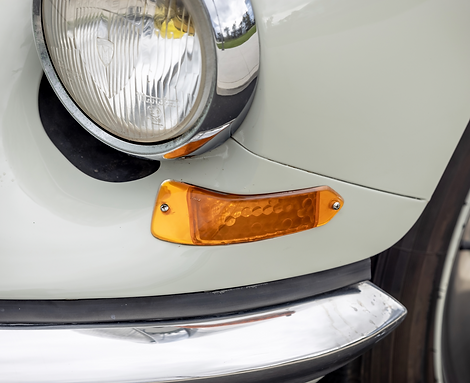
European front turn signal made by Seima or AXO

USA front turn signal - Lucas lamp with aluminum housing (chrome used on Pallas models)
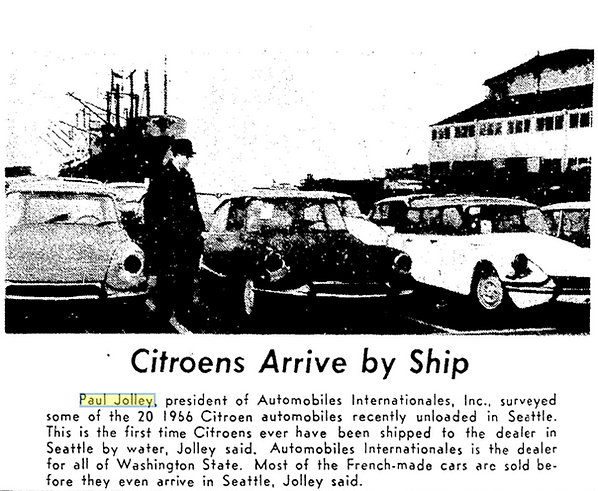
1966 DS’s arriving at the Port of Seattle - headlights removed
In 1966/1967, Canadian Specification DS's had the same Lucas turn signals that were used on USA cars. While the turn signals were USA-style, it seems that the headlights themselves were of the Euro type (quartz iodine).
TAIL LAMPS
On USA and Canadian sedans in 1966 and 1967, the rectangular Euro tail lamps made by Seima were replaced with round units made by Lucas of England. The Lucas tail lamps were standard lights used on many British cars of the era. A summary of sedan rear tail lamps can be found HERE.

Typical USA rear lighting as would be found on 1966-1969 cars - Lucas tail lamps (lenses held on with two Pozidriv screws), Lucas license plate lamps
REAR TURN SIGNALS
According to the parts books, the roof-mounted rear turn signals on 1966 sedans in the USA were Lucas units where the lenses were removed by twisting the lens counterclockwise (the so-called Lucas twist-off). In 1967, the parts books indicates that the lamps changed to one similar to the brake and tail lights (lenses held on with screws). While this is generally true, there seem to be exceptions where 1966’s had the later turn signal lamps. A summary of sedan rear turn signal configurations can be found HERE.
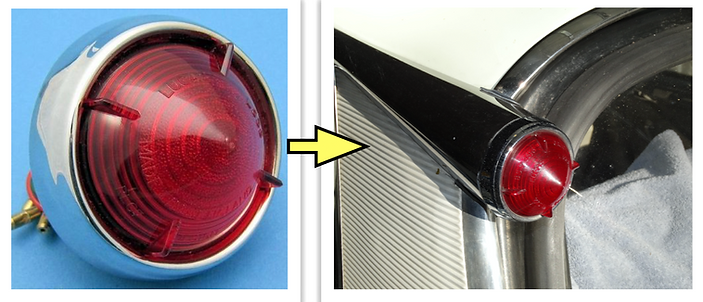
Lucas lamp with twist-off lens - used for roof-mounted rear turn signals on USA and Canadian 1966 DS sedans (and maybe a few 1967’s)

USA: 1958 to 1966
USA: 1967 to 1969
USA: 1970 to 1972
WAGON REAR LICENSE PLATE LIGHTING
Starting in 1961, US and Canadian station wagons received a special rear license plate holder on the lower tailgate that was designed to fit USA or Canada license plates (US and Canadian license plates are are almost the same shape/size). This holder was hinged such that the plate could be viewed with the tailgate open or closed. The license plate lights on the hinged panel were the same Lucas units that were used on USA sedans.
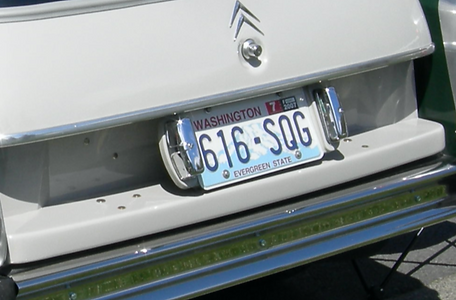
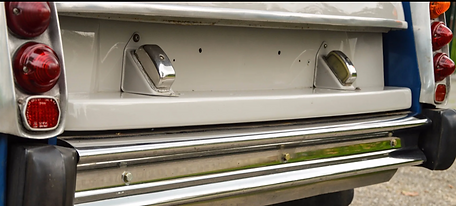
Euro-style license plate lamps
Typical USA wagon with folding license plate holder - notice plugs installed in the holes for the Euro license plate lights
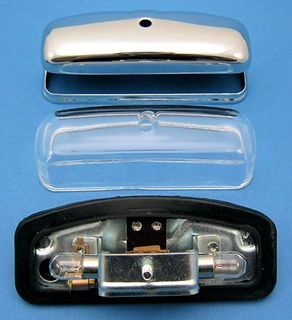

Lucas license plate light - used on all 1966-1972 DS sedans and wagons for the USA

Details of the hinging rear license plate holder on USA/Canadian wagons
WAGON TAIL LAMPS
DS wagon tail lights in 1966/1967 in Europe used lamps made by either Seima or AXO. Memories and photos suggest that the Seima versions shown in the photo were the only ones delivered on USA wagons.
A summary of wagon tail lamps can be found HERE.
Seima tail lights as found on a USA 1966/1967 wagon
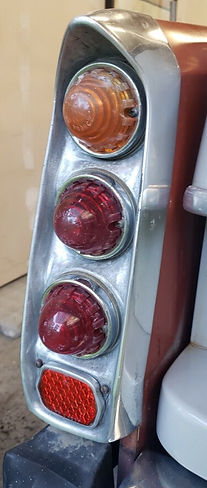
CONVERTIBLE LIGHTING
USA convertibles in 1966/1967 had the typical USA front end lighting that USA sedans and wagons had.
The boomerang turn signals mounted on the rear deck on Euro cars were not used on USA cars. Instead, turn signals were incorporated into the tail lamps using dual filament bulbs in the Lucas receptacles.
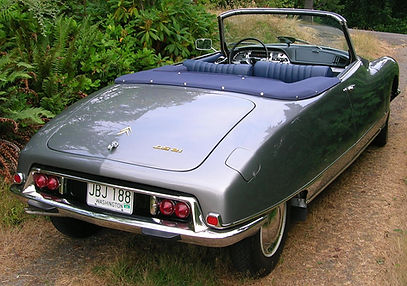
USA convertible without boomerang turn signals
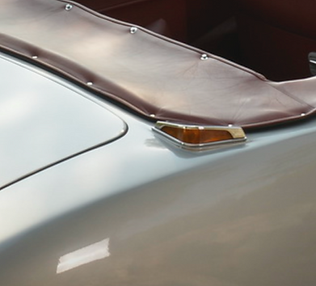
Boomerang turn signal on rear deck of a Euro convertible
But if you look a bit closer, not only were the boomerang turn signals absent on USA cars, the entire rear body section was different! Notice that on European convertibles, there was a raised boss on the rear body for the rear turn signal lamps. On USA cars, this area was completely flat. This is also true for earlier DS19 / ID19 convertibles shipped to the USA, which you can read about HERE.

USA convertible with no raised boss

Euro convertible with raised boss for the boomerang turn signal
We are still researching which rear turn signals that Canadian convertibles had. It is looking like early convertibles in Canada had turn signals that matched USA lighting, but in the years 1968-1971, they seem to have had the Euro boomerang turn signals. Stay tuned.
CANADIAN DS LIGHTING
The parts books suggest that Canadian DS’s in 1966/1967 had full Euro lighting. However, this is clearly in error. There are plenty of memories and photos showing 1966/1967 Canadian DS’s with the USA-style Lucas turn signals and tail lights. An example is a popular Canadian publicity photo, taken at the Mount Royal Observatory in Montreal. One can clearly see the USA-style Lucas tail lamps and turn signals (both front and rear). It seems that while some of the exterior lighting was USA-style, the headlights themselves were stil quartz iodine instead of the sealed beams on USA cars.

1966/1967 Citroën publicity photo in Montreal showing a Canadian car with USA front turn signals but with Euro-style headlights.
HYDRAULIC FLUID
Model year 1967 was the year that Euro DS’s received LHM hydraulic fluid. LHS2 (brake fluid) was retained until 1969 ½ on USA and Canadian Specification cars.
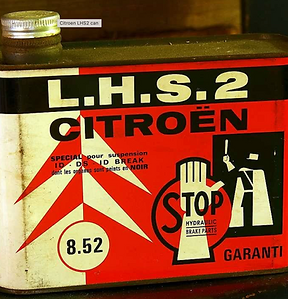

LHS2 was used in the USA several years after European DS's started using LHM
DASHBOARD AND WIRING
USA model DS's and ID's always had the speedometer calibrated in MPH.
Another difference was associated with the turn signals. A USA requirement exists that if a turn signal bulb on a car fails, the bulb’s failure must be somehow indicated to the driver. A requirement that covers this is Federal Motor Vehicle Safety Standard (FMVSS) No. 108. While FMVSS 108 wasn’t enacted until 1968, a similar requirement appears to have been in place earlier in the form of an SAE design standard. Here is a relevant excerpt from FMVSS 108:
“…Failure of one or more turn signal lamps…..must be indicated by the turn signal pilot indicator (dash light) by a “steady on”, “steady off”, or by a significant change in the flashing rate…”
We think a SAE design standard is what drove Citroën to develop unique turn signal parts for cars intended for the USA, including different turn signal switches and external turn signal flasher units (most Euro DS’s had turn signal flashers that were integral to the switch). The external turn signal flasher for USA cars (made by Klaxon) is shown below. Notice it is stamped "USA."
Cancelling the turn signal on USA switches on cars between 1966 and early 1969 was accomplished by pulling the lever aft, toward the driver.
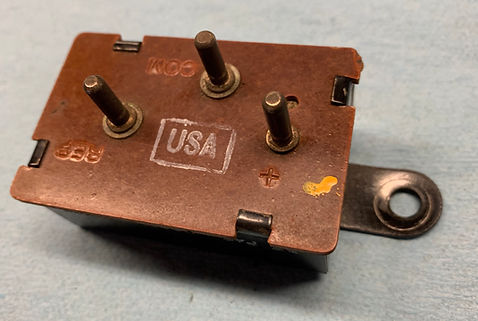

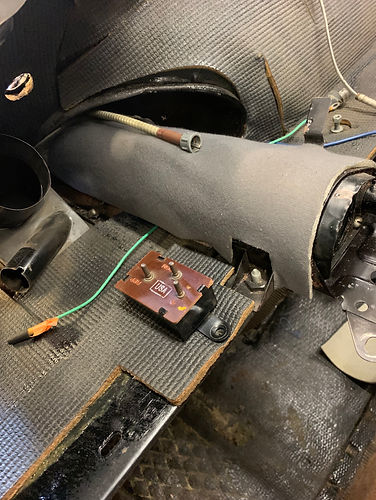
KLAXON turn signal flasher unit as found on a 1966 USA DS (part number DM 575 100A)
Canadian cars had the speedometer calibrated in miles-per-hour (MPH). The parts books suggest that Canadian cars had the Euro turn signal switch and associated wiring, although this needs confirmation.
ID19 REAR VIEW MIRROR
DS21 models in the USA had the same rear view mirror as their Euro counterparts. These mirrors contained a DAY/NIGHT function and were generally a bit larger than the rear view mirrors on ID19 models. Rear view mirrors on Euro ID19's did not get the DAY/NIGHT function.
Citroën developed a unique rear view mirror for USA ID19's that had a DAY/NIGHT function and was slightly larger. There were several different mirror part numbers between 1966 and 1969 on USA ID19's. By 1970, the factory included large mirrors with a DAY/NIGHT function on D-Specials, thus eliminating the need for a unique mirrors on USA cars.
What drove Citroën to develop a unique mirror for the USA? It would seem logical that a USA regulation would be behind it. In fact, by 1968, USA rules required a DAY/NIGHT function per Federal Motor Vehicle Safety Standard (FMVSS) No. 111, "Rear Visibility". But prior to when the FMVSS kicked in, we think an SAE standard probably caused the change.
The photo below shows the 1966 versions (Euro and USA).
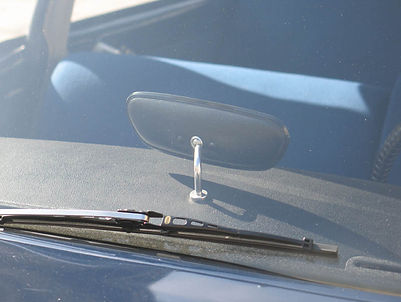
Euro rear view mirror with no DAY/NIGHT function

USA rear view mirror with DAY/NIGHT function
COLD WEATHER PACKAGE (-15C)
Citroën had cold weather options available for the DS/ID since the early 1960's. By the mid-1960's they were calling these the -5C, -15C, or -20C cold weather option, each with different traits.
Canadian cars received the -15C option as standard equipment starting in 1965 or perhaps 1966. This is documented in several places, such as two Montreal Gazette newspaper articles from 1965 and 1966; HERE and HERE.
The -15C option consisted of an auxilary heater and a cable-operated flap in the duct to the radiator. You can read a bit more about this option HERE.
Then there was the mysterious engine block heater that we think all 1966-1972 Canadian DS's were equipped with. The block heater was not part of Citroën's cold weather option. So who installed the block heaters? Since it is not shown in the parts book, it was apparently installed by Citroën Canada employees once the cars were in Canada, as a port-installed part. Both west coast and east coast DS's in Canada had the block heater. We can find no documentation on it at all, but we think it is part of the Canadian Specification that was adopted in 1965/1966. There are a few additional photos of the block heater in the General Information '66-'72 section.

Exploded view of the rear seat heater

Chris Dubuque
Mysterious engine block heater on most (all?) Canadian cars

Chris Dubuque
Engine block heater was made in Canada

Jeff Lannigan
Rear Seat Heater on a DS sedan
BRAKE PADS
Starting in 1966, the parts books show that USA cars started receiving unique front brake pads and rear brake shoes. The unique pads and shoes are described as SAFF components. I had to look up what SAFF meant. Here is what I found:
"...In 1923, Eugène Buisson, the French representative for Ferodo brake linings, opened workshops in France to manufacture, under license, his own friction materials. This was the birth of Société Anonyme Française de Ferodo (SAFF)...."
By 1970, another brand of brake pads was approved for use on USA cars; Textar. We think that the unique brake pads were most likely associated with a US regulation of the era, although I was unable to find the specific rule.
It is unclear what brake pads Canadian cars were using in these years.

TIRES
Tires delivered on DS’s intended for the USA were different than tires delivered on Euro versions.
For one thing, all USA sedans and wagons had the same size tire in all five positions (front, rear, and spare). Most of the Euro models had narrower tires in the rear.
All 1966/1967 DS sedans and wagons sold in the USA were equipped with 180-380 Michelin XAS tires, front and rear. Note that the 180-380 size is also referred to in the English convention as 180-15, later called 180HR15.
We believe that all Canadian 1966 to 1972 sedans and wagons were delivered with 180-380 XAS tires (front, rear, and spare).
Michelin 180-380 XAS with asymmetric tread


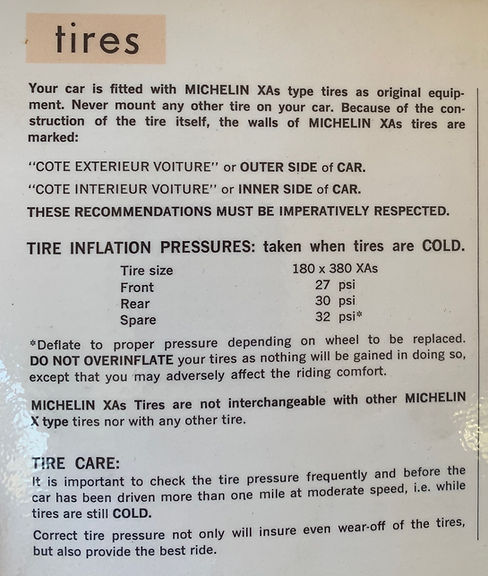
Owners Manual from a USA 1966 Wagon - specifying Michelin XAS tires
Hal Landvoigt